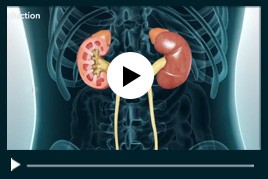Pelvic Prolapse or Pelvic Organ Prolapse
Men's health :: Female Urology :: Paediatric Urology
Infections :: Urethral diverticulum :: Pelvic prolapse :: Urinary tract injuriesPregnancy & Urinary tract :: Urinary Incontinence :: Haematuria :: Cancer
Pelvic organ prolapse means that the uterus and/or the vagina have fallen down from its normal position in the pelvis. This prolapse is probably caused by injuries sustaining during childbirth, aging, a woman's tissue composition, chronic coughing and heavy lifting.
In addition to sagging of the bladder into the vagina ( cystocele ), pelvic prolapse can result in bulging of the rectum into the vagina ( rectocele ), and/or bulging of the intestine into the top of the vagina ( enterocele ). An urethrocele or decreased support of the tube leading out of the bladder is commonly seen with a cystocele. If you have not had a hysterectomy, the uterus (womb) may drop to varying degrees ( uterine prolapse ). Mild pelvic prolapse requires no treatment. If treatment is necessary, it is best to treat all of the support problems simultaneously to get the best long-term results. Pelvic prolapse is caused by tears in a tissue called fascia. Fascia is a strong canvas-like tissue that supports the bladder, vagina, and rectum. It is also found in many other areas of the body.
Factors that increase the likelihood of pelvic prolapse involve:
- multiple pregnancy with vaginal delivery
- obesity
- chronic coughing (such as with smoking or chronic bronchitis)
- heavy lifting & frequent straining
- Hormone imbalance
Lifestyle changes may reduce the risk of pelvic prolapse or decrease the symptoms.
Symptoms resulting from pelvic prolapse can include:
- Sensation of heaviness in the vagina
- pelvic and low back pain
- difficulty in passing urine
- Frequent urinary tract infections
- vaginal irritation
- difficulty having a bowel movement so you have to push on your bottom
- the feeling that something is coming out of the vagina
- Painful sexual intercourse
Degrees of prolapse
Uterine prolapse is categorised by the degree of tissue protruding into the vagina. In most cases, other pelvic organs (such as the bladder or bowel) are also prolapsed into the vagina, and the ovaries sit lower than normal inside the pelvis. The three categories of uterine prolapse are:
First degree (mild) - the neck of the uterus (cervix) protrudes into the lowest third of the vagina.
Second degree (moderate) - the cervix protrudes to the opening of the vagina.
Third degree (severe) - the whole uterus protrudes out of the vagina.
If the prolapse is not severe, some patients respond to medical or non-surgical treatment of pelvic prolapse. Alternatives to surgery can include:
- lifestyle modification such as quit smoking, losing weight, and getting allergy treatments
- Pelvic floor or Kegel's exercises which are regular contraction of the muscles that allow you to stop urine in mid-stream - this may reduce or eliminate incontinence
- pessary use which is usually a donut-shaped rubber or plastic device inserted into the vagina to provide support
- hormone replacement therapy
If surgery is necessary for treatment of pelvic prolapse, several different procedures can be performed. The choice of procedure(s) depends on the specific problem(s), any associated problems, and the preference of your physician.
In laparoscopic surgery, slender instruments are inserted through the navel. The uterus is pulled back into its proper place and reattached to supporting ligaments using permanent stitches. Over time, scar tissue grows over these stitches and further strengthens the repair. The operation may be performed abdominally in some circumstances. In around nine out of 10 cases, corrective surgery is successful

 Menu
Menu




